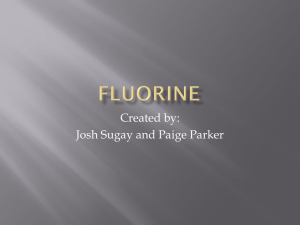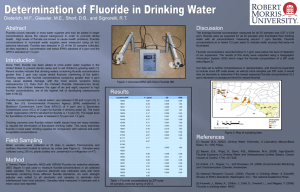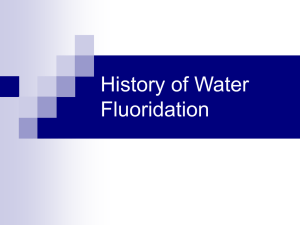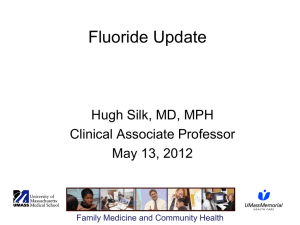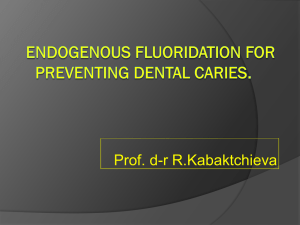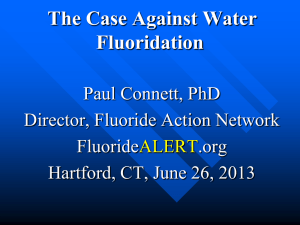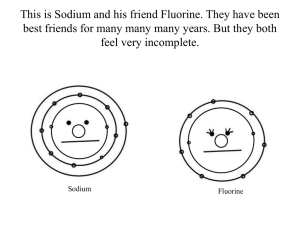Jeff Zidek Fluoridation Safety Seminar - Ims
advertisement
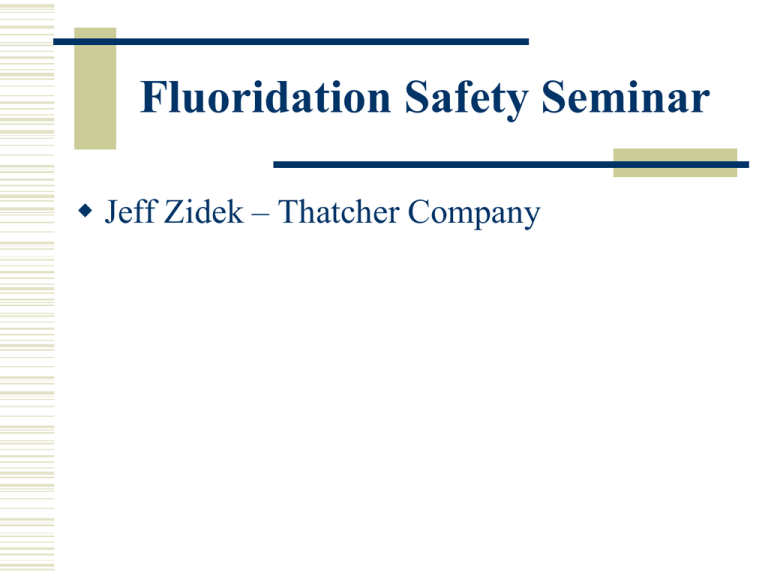
Fluoridation Safety Seminar Jeff Zidek – Thatcher Company Introduction The purpose of this presentation is to introduce some important safety facts and other useful information regarding fluoridation. Some properties of Fluoride Practical handling of Fluoride The main health hazards associated with Fluoride Safety Safety is the name of the game. Play by the rules. Safety Overview Respect and consider the hazards of the chemical Consider your personal safety always Consider the others with whom you are working and their safety Consider the purpose of the chemical that is being use and know the name of the chemical Fluorine Fluorine is a gas. Fluorine is the thirteenth most abundant element found in the earth’s crust. Fluorine is always found as a combination of chemicals. When the compound is dissolved in water the compound dissociates into ions such as table salt. It is the fluoride ions that we are interested in for public benefit. Chemical Sources Fluoride can be found in a solid form in minerals such as fluorspar, cyrolite and apatite. Due to the dissolving power of water, fluoride is found naturally in all waters. In general, the deeper the groundwater, the greater the natural concentration of fluoride in the water. Drinking Water Fluoride Compound Additives Sodium Fluoride Sodium Fluorosilicate Hexafluorosilicic Acid (Hexafluorosilicic Acid) HFS or HFA Sodium Fluoride Sodium Fluoride (NaF) is a white, odorless material available as either a powder or in the form of crystals. Powdered Sodium Fluoride is produced in different densities: Light grade – Less than 65 pounds per cubic foot Heavy grade – About 90 pounds per cubic foot. Sodium Fluorosilicate Sodium Fluorosilicate (Na2SiF6) Sodium Fluorosilicate is a white, odorless crystalline powder. Sodium Fluorosilicate is 98% or greater in purity. Sodium Fluorosilicate is sold in the same densities as sodium fluoride. Hexafluorosilicic Acid Hexafluorosilicic Acid (H2SiF6). Hexafluorosilicic Acid is a straw-colored, transparent liquid. Hexafluorosilicic Acid is a 20 to 35 percent solution with a pH of 1.2 Hexafluorosilicic Acid must be handled with care. Safety Fluoride is an extremely safe compound at the 1 ppm level found in water supplies. Operators may be exposed to higher levels by handling the chemicals. The use of safety equipment is strongly recommended when handling fluoride compounds or performing maintenance. Safety Gear for Fluoride Powders Wear protective clothing NIOSH/MSHA approved dust respirator Goggles Gauntlet neoprene gloves (12” minimum length) Heavy duty neoprene apron High top boots Safety Gear for Fluoride Powders Continued… Protective clothing should always be worn whenever handling the fluoride powders. Protective clothing should be stored near the entrance of the area where the fluoride powders are stored. Avoid wearing the protective clothing into other parts of the water plant. Handling Bags of Fluoride Powder Use a knife to open the bags and make a clean cut. Gently pour the powder into the saturator to raise as little dust as possible and empty the bags completely. Do not store partially filled bags of powder for later use. Handling Bags of Fluoride Powder Continued… Dispose of empty bags and wash your hands immediately after handling the powder/bags. Never eat, drink or smoke in the area where the fluoride is used or stored. Dissociation of H2SiF6 H2SiF6 = 2HF + SiF4(gas) And SiF4(gas) + 2H2O = 4HF + SiO2(solid) And SiF4(gas) + 3H2O = 4HF + H2SiO3(acid) And HF = H + F Safety Gear for Hexafluorosilicic Acid Always wear protective clothing. Gauntlet neoprene gloves (12” minimum length) Full 8” face shield and/or acid type safety goggles. Heavy duty acid type neoprene apron Tall Chemical Resistant Boots Safety showers should be located. Safety Gear Continued… Only Neoprene, PVC and Natural Rubber gloves are acceptable while handling fluorine products. Latex and Nitrile gloves are not acceptable. Handling Hexafluorosilicic Acid Keep the acid off clothes and skin and don’t breathe in the fumes. Use a transfer pump to move the acid from one container to another. Handling Hexafluorosilicic Acid Continued… Dispose of empty acid containers as required by state law. Wash your hands, equipment and protective clothing after handling Hexafluorosilicic acid. Do this immediately and before you do anything else. Never eat, drink or smoke in areas where the acid is stored or used. Spill and Releases All spills must be handled with care. 1. 2. 3. Steps to follow in the event of a spill or release. Isolate the spill area and deny entry. Stay upwind of the spill Do not touch or allow anyone to touch the spilled or leaked product. Spill and Releases Continued… 4. 5. 6. Use Personal Protective Equipment Try to stop the source of the leak if it is safe to do so. Contain the spill so that it will not reach the public ground or surface water. Prevent discharge into sewers and waterways. Spill and Release Containment Build a dike around the spill using lime (Ca(OH)2) Do not use soda ash or caustic as this will form sodium fluorosilicate and sodium fluoride (both of these compounds are regulated as hazardous substances) Lime will neutralize HFS liquid to form the insoluble calcium fluoride. Spill and Release Containment Continued… Lime Neutralization H2SiF6 + Ca(OH)2 forms CaSiF6 + 2H20 CaSiF6 + 2Ca(OH)2 forms 3CaF2 + Si02 + 2H2O 0.4 pounds of lime will neutralize 1 pound of HFS liquid solution Spill and Release Containment Continued… DO NOT use metal buckets to recover any HFS acid as it will react readily with metal. Spill and Release Containment Continued… Spillage HFS Liquid Lime Required 1 pound 0.12 pounds 55 gallons 65 pounds 1 – tote Call HAZMAT Bulk Call HAZMAT Any spills larger than 55 gallons should have a HAZMAT response team Fluoride Exposure There are two kinds of toxic exposure Chronic toxic exposures (large doses of fluoride spread over several years) and Acute toxic exposures (a single massive dose) Chronic Toxic Exposure Low level prolonged exposure (2 to 8 times that of the optimal level) can mottle the enamel of the teeth. At higher prolonged levels of exposure and fluoride intake, osteosclerosis, calcification of ligaments and tendons, and or vertebrate consolidation can occur. Acute Toxic Exposure Acute fluoride poisoning may result from ingestion, inhalation or bodily contact with concentrated fluoride compounds. Accidental ingestion is quite unlikely and not a lot is known about acute fluoride poisoning by ingestion because it is a very rare occurrence. Acute Toxic Exposure Continued… Some Symptoms of acute poisoning The body will tell us if there has been an overexposure to fluoride: Overdoses will include: Vomiting Stomach Cramps Muscular Weakness Difficulty in speaking Disturbed color vision and thirst Toxic Exposure Concentrations of fluoride of 1.0 ppm has been exhaustively studied and firmly established as safe beyond question. To prevent overexposure, the best safety measure is proper handling of fluoride chemicals. Fumes from HFS When fumes become irritating to the nose. STOP IMMEDIATELY Apply 3M Full face Respirator with 6006 Multi Gas Vapor Cartridge Fumes from HFS continued… HFS is a very unique chemical. Irritation of the nose is the first sign that a respirator must be donned. A bloody nose follows the irritation if action is not taken. First Aid for Acute Toxic Exposure First aid treatment should be started while waiting for medical help. First Aid for Air-Borne Fluorides (Nose Bleed) Move the victim from the exposed area Keep the victim quiet; Place the victim in a sitting position, leaning forward if possible; If leaning forward is not possible; place the victim in a reclining position with the head and shoulders raised First Aid for Air-Borne Fluorides (Nose Bleed) Cont... Apply pressure directly by pressing the bleeding nostril toward the midline Apply a cold compress to the victim’s nose and face. Insert a small, clean pad of gauze (not absorbent cotton) into the nostrils and apply external pressure. Obtain medical assistance. Skin Exposure from HFS Skin exposure from liquid HFS is more hazardous than breathing the vapors. When liquid HFS comes in contact with the skin, it feels much like water. Liquid HFS penetrates the skin quickly, burning the skin and absorbing into tissue. The pain will become intense, deep if not washed off immediately. First Aid for Acid Splash Wash away the chemical with large amounts of water as quickly as possible. Remove the victims clothing from the affected area and continue washing for at least 5 minutes. Where skin damage has occurred, cover the burns with a dressing bandage. First Aid for Acid Splash Continued… If the eye is involved, immediately begin to wash the eye, eyelid and face. Hold the eyelid open and wash the eye for at least 15 minutes. After a thorough washing, cover the eye with a clean, dry protective dressing and hold bandage in place. Even seemingly minor eye injuries can become serious. Seek immediate medical assistance for the victim. Questions?

